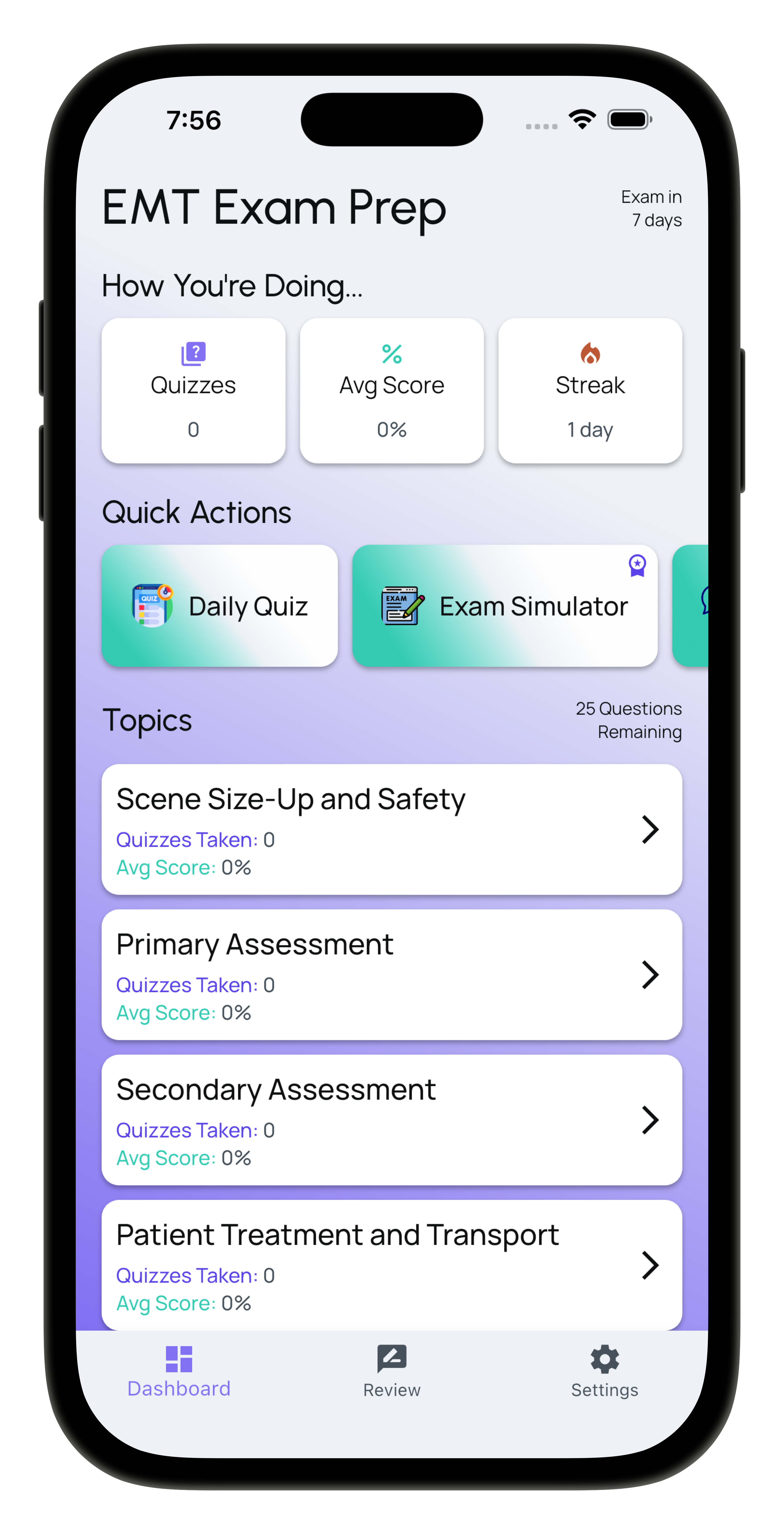EMT Exam Prep 2025
In the high-pressure environment of emergency medical services (EMS), patient assessment is a critical skill that can mean the difference between life and death. For EMT candidates preparing for certification, understanding the intricacies of patient assessment not only enhances clinical skills but also boosts confidence in real-world scenarios. This blog post will delve into the essential components of patient assessment, providing practical tips and strategies to ensure you are well-prepared for your NREMT exam and your future career in EMS.
The Importance of Patient Assessment
Patient assessment is the systematic process of evaluating a patient’s condition to determine the appropriate course of action in an emergency. This process involves gathering information about the patient’s medical history, current symptoms, and vital signs. Mastery of patient assessment is crucial for several reasons:
- Timely Intervention: Rapid assessment allows EMTs to identify life-threatening conditions and initiate treatment promptly.
- Patient Safety: Thorough assessments help prevent misdiagnosis and ensure that the correct interventions are applied.
- Effective Communication: Accurate and concise assessments facilitate better communication among healthcare providers during transitions of care.
Key Components of Patient Assessment
To effectively assess a patient in an emergency situation, EMTs must follow a structured approach. The assessment process can be broken down into the following key components:
1. Scene Size-Up
The first step in any assessment is the scene size-up, which involves evaluating the environment for safety and understanding the mechanism of injury or nature of the illness. Key considerations include:
- Safety: Ensure that the scene is safe for both the patient and the responders.
- Mechanism of Injury (MOI) or Nature of Illness (NOI): Gather information about how the injury occurred or the symptoms presented.
- Number of Patients: Assess how many patients require care and whether additional resources are needed.
2. Primary Assessment
Once the scene is deemed safe, the primary assessment focuses on identifying immediate life threats. This assessment follows the ABCDE approach:
- Airway: Check for patency. Is the airway open? If not, consider airway adjuncts or maneuvers to clear obstructions.
- Breathing: Assess the quality of breathing. Is the patient breathing adequately? Look for signs of respiratory distress.
- Circulation: Evaluate pulse, skin condition, and capillary refill. Check for any major bleeding and control it as necessary.
- Disability: Perform a quick neurological assessment using the AVPU scale (Alert, Verbal, Pain, Unresponsive) to determine the patient’s level of consciousness.
- Exposure: Expose the patient to identify any hidden injuries while maintaining their dignity and warmth.
3. Secondary Assessment
The secondary assessment is a more detailed examination and is often performed after stabilizing life-threatening conditions. This includes:
- Patient History: Gather information using the SAMPLE acronym:
- S: Signs and Symptoms
- A: Allergies
- M: Medications
- P: Past Medical History
- L: Last Oral Intake
- E: Events Leading Up to the Present Illness/Injury
- Physical Examination: Conduct a head-to-toe exam, looking for signs of injury, deformities, or unusual findings.
Practical Assessment Techniques
In addition to understanding the components of patient assessment, it’s vital to refine your assessment techniques. Here are some practical tips:
- Practice, Practice, Practice: Use the EMT Exam Prep app to engage with NREMT-style practice questions that reinforce assessment scenarios. Practicing in realistic settings will help solidify your skills.
- Mock Assessments: Participate in simulation training with peers or instructors. This realistic practice helps to build muscle memory and improve your confidence when assessing patients.
- Utilize Checklists: Having a mental or physical checklist can help ensure that no steps are missed during the assessment process.
Real-Life Application and Scenario-Based Learning
Understanding patient assessment goes beyond theory; applying this knowledge in real-life scenarios is crucial. Here’s an example to illustrate:
Scenario: You arrive on the scene of a motor vehicle collision. The driver is disoriented and complaining of chest pain.
- Scene Size-Up: Ensure safety, assess the vehicle for hazards, and note the MOI.
- Primary Assessment: Check the airway and breathing. The patient is responsive but has labored breathing and signs of shock (pale, clammy skin). Control any visible bleeding and administer oxygen if needed.
- Secondary Assessment: Using the SAMPLE method, gather further information from the patient and bystanders. Check vital signs and perform a thorough physical exam, noting any potential injuries.
Conclusion
Mastering patient assessment is a vital skill for EMT candidates and emergency responders alike. A systematic approach not only aids in rapid identification of life-threatening conditions but also enhances overall patient care. As you prepare for your NREMT certification, remember that effective patient assessment is a combination of knowledge, practice, and experience. The EMT Exam Prep app can be your trusted companion in this journey, providing the tools and resources necessary to succeed. With diligent study and practical application, you will be well on your way to becoming a competent and confident EMT, ready to make a difference in emergency situations.
Ready to become a certified EMT? Try EMT Exam Prep 2025 for comprehensive NREMT-style practice questions with detailed explanations covering all essential certification content areas.
